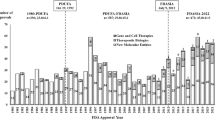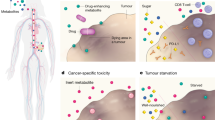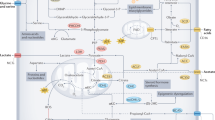Abstract
Despite the intense interest in biomarker development for cancer management, few biomarker assays for diagnostic uses have been submitted to the US Food and Drug Administration (FDA). What challenges must researchers overcome to bring cancer-detection technologies to the market and, therefore, into clinical use?
This is a preview of subscription content, access via your institution
Access options
Subscribe to this journal
Receive 12 print issues and online access
$209.00 per year
only $17.42 per issue
Buy this article
- Purchase on Springer Link
- Instant access to full article PDF
Prices may be subject to local taxes which are calculated during checkout

Similar content being viewed by others
References
Guttmacher, A. E. & Collins, F. S. Realizing the promise of genomics in biomedical research. JAMA 291, 1399–1402 (2005).
Shak, S. et al. A multigene assay to predict recurrence of tamoxifen-treated, nod-negative breast cancer. N. Engl. J. Med. 351, 2817–2826 (2004).
van de Vijver, M. J. et al. A gene-expression signature as a predictor of survival in breast cancer. N. Engl. J. Med. 347, 1999–2009 (2002).
Meyerson, M. & Carbone, D. Genomic and proteomic profiling of lung cancers: lung cancer classification in the age of targeted therapy. J. Clin. Oncol. 10, 3219–3226 (2005).
Baruch, A. C., Shi, J., Feng, Y. & Nelson, M. A. New developments in the staging of melanomas. Cancer Invest. 23, 561–567 (2005).
Zhou, G. et al. Proteomic analysis of global alteration of protein expression in squamous cell carcinoma of the esophagus. Proteomics 5, 2814–3821 (2005).
Chen, R. et al. Pancreatic cancer proteome: the proteins that underlie invasion, metastasis, and immunologic escape. Gastroenterology 129, 1344–1347 (2005).
US Food and Drugs Administration. Federal Food, Drug, And Cosmetic Act. US Food and Drugs Administration [online], (2004).
Goehring, C., Perrier, A. & Morabia, A. Spectrum bias: a quantitative and graphical analysis of the variability of medical diagnostic test performance. Stat. Med. 15, 125–135 (2004).
Punglia, R. S., Kuntz, K. M., Catalona, W. J. & D'Amico, A. Operating characteristics of prostate-specific antigen and verification bias. JAMA 294, 2698–2699 (2005).
Zang, D. et al. Reliability of tissue microarrays in detecting protein expression and gene amplification in breast cancer. Mol. Pathol. 16, 79–84 (2004).
US Food and Drugs Administration. 510(k) Premarket notification database. US Food and Drugs Administration [online], (2006).
Pepe, M. S. et al. Phases of biomarker development for early detection of cancer. J. Natl Cancer Inst. 93, 1054–1061 (2001).
US Food and Drugs Administration. Electronic code of federal regulations. US Food and Drugs Administration [online], (2006).
US Food and Drugs Administration. Guidance on informed consent for in vitro diagnostic device studies using leftover human specimens that are not individually identifiable — guidance for sponsors, institutional review boards, clinical investigators and FDA staff. US Food and Drugs Administration [online], (2006).
Bast, R.C. Jr. et al. Translational crossroads for biomarkers. Clin. Cancer Res. 11, 6103–6108 (2005).
Ludwig, J. A., & Weinstein, J. N. Biomarkers in cancer staging, prognosis, and treatment selection. Nature Rev. Cancer 5, 845–856 (2005).
US Food and Drugs Administration. Voluntary genomic data submissions: FDA Guidance. US Food and Drugs Administration [online], (2005).
Ramakrishnan, R. et al. An assessment of Motorola CodeLink microarray performance for gene expression profiling applications. Nucleic Acid Res. 30, 1–12 (2002).
Yudong, D. et al. Microarray standard data set and FIGS or merit for comparing data processing methods and experiment designs. Bioinformatics 19, 956–965 (2003).
Pusztai, L. & Hess, K. R. Clinical trial design for microarray predictive marker discovery and assessment. Ann. Oncol. 15, 1731–1737 (2004).
Gong, P., Harbers, G. M. & Grainger, D. W. Multi-technique comparison of immobilized and hybridized oligonucleotide surface density on commercial amine-reactive microarray slides. Anal. Chem. 78, 2342–2351 (2006).
Dorris, D. R. et al. A highly reproducible, linear, and automated sample preparation method for DNA microarrays. Genome Res. 12, 976–984 (2006)
Petricoin, E. F. et al. Use of proteomic patterns in serum to identify ovarian cancer. Lancet 359, 572–577 (2002).
Ransohoff, D. E. Bias as a threat to the validity of cancer molecular-marker research. Nature Rev. Cancer 5, 142–149 (2005).
Diamandis, E. Analysis of serum proteomic patterns for early cancer diagnosis: drawing attention to potential problems. J. Natl Cancer Inst. 96, 353–356 (2004).
Saah, A. J. & Hoover, D. R. Sensitivity and specificity reconsidered: the meaning of these terms in analytical and diagnostic settings. Ann. Intern. Med. 1126, 91–84 (1997).
Gutman, S. & Meyer, D. Lexicon for laboratories — scaling the Tower of Babel. Arch. Pathol. Lab. Med. 127, 625–626 (2003).
Hagdu, A. The discrepancy in discrepant resolution. Lancet 348, 592–593 (1996).
Bossuyt, P. M. et al. Towards complete and accurate reporting of studies of diagnostic accuracy: the STARD initiative. Standards for Reporting of Diagnostic Accuracy. Clin. Chem. 49, 19–20 (2003).
McShane, L. M., et al. Reporting recommendations for tumour MARKer prognostics studies (REMARK). Br. J. Cancer 93, 387–391 (2005).
Schatzkin, A., Connor, R. J., Taylor, P. R. & Bunag, B. Comparing new and old screening tests when a reference procedure cannot be performed on all screenees. Example of automated cytometry for early detection of cervical cancer. Am. J. Epidemiol. 125, 672–678 (1987).
US Food and Drugs Administration. Statistical Guidance on reporting results from studies evaluating diagnostic tests; draft guidance for industry and FDA reviewers. US Food and Drugs Administration [online], (2003).
Clinical Laboratory Standards Institute. Assessment of the clinical accuracy of laboratory tests using receiver operating characteristics (ROC) plots, approved guideline. Clinical Laboratory Standards Institute (1995).
Dobbin, K. & Simon, R. Sample size determination in microarray experiments for class comparison and prognostic classification. Biostatistics 6, 27–38 (2005).
Campbell, G. Some statistical and regulatory issues in the evaluation of genetic and genomic tests. J. Biopharm. Stat. 14, 529–552 (2004).
Paik, S. et al. Real-world performance of HER2 testing — National Surgical Adjuvant Breast and Bowel Project experience. J. Natl Cancer Inst. 94, 852–854 (2002).
Roche, P. C. et al. Concordance between local and central laboratory HER2 testing in the breast intergroup trial N9831. J. Natl Cancer Inst. 94, 855–857 (2002).
US Food and Drugs Administration. Medical devices, part 820: quality system regulation. US Food and Drugs Administration [online], (2005).
US Food and Drugs Administration. Draft guidance for industry and FDA staff — pharmacogenetic tests and genetic tests for heritable markers. US Food and Drugs Administration [online], (2006).
Acknowledgements
The opinions expressed in this article are those of the authors and are not to be construed as official or as representing the opinion of the US Food and Drug Administration.
Author information
Authors and Affiliations
Corresponding author
Ethics declarations
Competing interests
The authors declare no competing financial interests.
Related links
Related links
DATABASES
National Cancer Institute
FURTHER INFORMATION
International Organization for Standardization (ISO)
Interagency Oncology Task Force (IOTF)
Current information on the FDA's review of genomic tests as part of drug discovery and development
Information on best practices for the VGDS process
Information on the preliminary thinking of the FDA about the co-development of diagnostics and drugs
Special controls for the first FDA-cleared microarray
Special controls for the first FDA-cleared microarray reader
Rights and permissions
About this article
Cite this article
Gutman, S., Kessler, L. The US Food and Drug Administration perspective on cancer biomarker development. Nat Rev Cancer 6, 565–571 (2006). https://doi.org/10.1038/nrc1911
Issue Date:
DOI: https://doi.org/10.1038/nrc1911
This article is cited by
-
Molecular classification of tissue from a transformed non-Hogkin’s lymphoma case with unexpected long-time remission
Experimental Hematology & Oncology (2017)
-
Tear fluid biomarkers in ocular and systemic disease: potential use for predictive, preventive and personalised medicine
EPMA Journal (2016)
-
Circulating biomarkers for gliomas
Nature Reviews Neurology (2015)
-
Sensor-Based Architecture for Medical Imaging Workflow Analysis
Journal of Medical Systems (2014)



